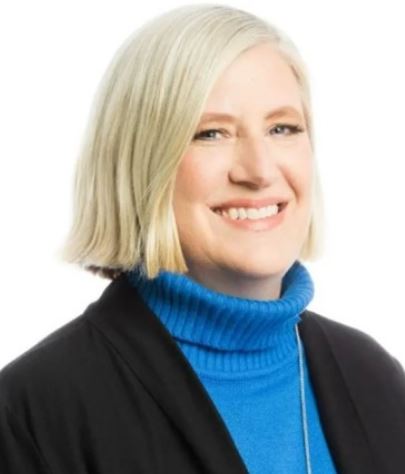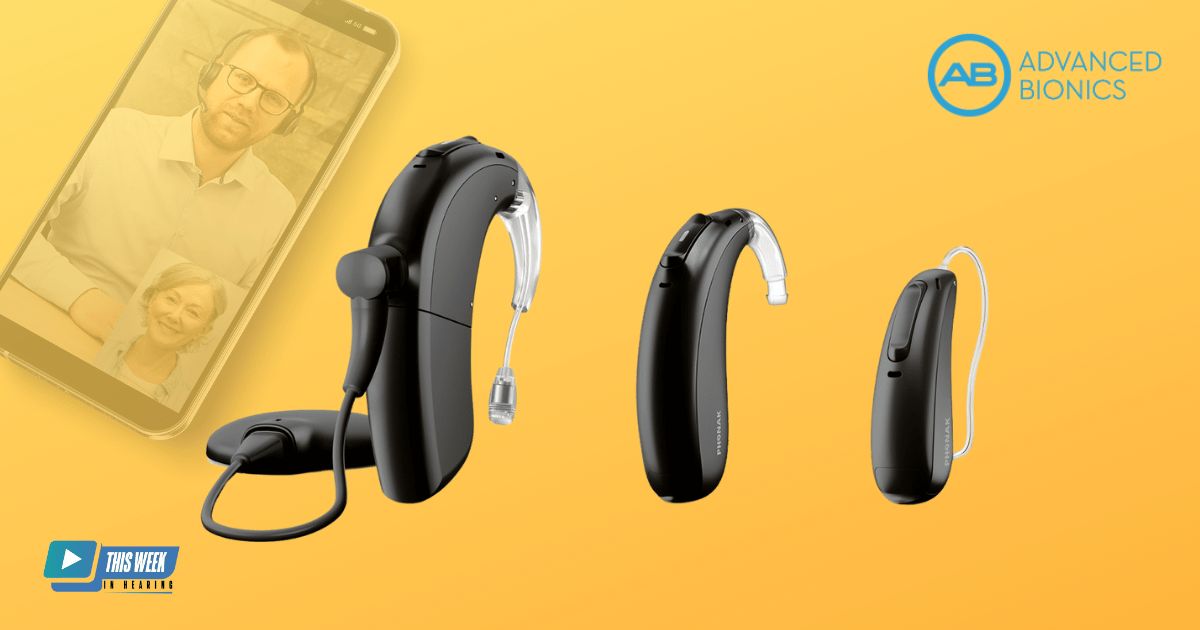Host Amyn Amlani speaks with Victoria Carr-Brendel, President of Advanced Bionics and Group Vice President (GVP) of Cochlear Implants at Sonova, about the recent advancements in AB’s Marvel cochlear implant product and its associated features.
Following FDA approval, the company is broadening its Marvel CI product line to include remote programming accessible via patients’ smartphones, linked two-ear solutions featuring a CROS device, all aiming to enhance accessibility and outcomes for cochlear implant users. Moreover, the updated Target CI version 1.5 is designed to improve programming software efficiency for both cochlear implants and hearing instruments, underscoring AB’s commitment to advancing hearing care options.
Throughout the discussion, Carr-Brendel highlights how transformative remote programming is and how it aligns with Advanced Bionics’ mission to expand hearing care access. She stresses its potential to greatly benefit patients who previously faced barriers due to traditional clinic-based limitations, emphasizing its capacity to boost patient engagement and simplify the programming process for audiologists.
References:
Full Episode Transcript
Advanced Bionics recently announced expansion of its Marvel cochlear implant product and feature offerings to improve hearing care delivery and patient outcomes. I’m joined today by Vicky Carr-Brendel , President of Advanced Bionics and Group Vice President of cochlear implants. So, Vicky, three points were reported in this recent announcement, and I thought for our viewership, we’d go through each of these points one by one. The first is that remote programming is now available through the patient’s smartphone. Can you share, enlighten us a little bit about that new available hearing care accessible treatment intervention that you all have released? Yeah, we’re really excited about remote programming. And Sonova and AB have been really focused on our ESG, environment, social governance. And one of the things that, that stands for is hearing care access. So we know, obviously, our hearing instrument side of the business, but on the cochlear implant side of the business, it’s just as true. And what we find with people who are electing to get cochlear implants is that oftentimes they make the choice not to engage and get a cochlear implant because of the amount of maintenance that it takes to get a cochlear implant. So it could be the number of appointments, it could be the travel, it could be the cost of the travel, et cetera. So, remote programming offers us the opportunity to avail this type of health care to patients who are desperately in need of hearing and are hithertofore never been able to get that because they weren’t able to make the track, as it were. So what we’re so excited about is with remote programming, that should enable patients greater access and then even give some benefit to the healthcare providers, like audiologists, in that it should create less cancellations of appointments and the ability for them to be much more efficient in getting patients to get their cochlear implant programmed. Yeah. So, do you have an idea? and you may not have this exactly with you, but the average time that a patient travels outside of a typical jurisdiction, let’s call it 15 or 20 miles do you have any of that information so that our viewers would know, hey, these people are traveling two and three and 4 hours or 200, 300 miles in order to get services? Yeah, I don’t have the data offhand, but I can tell you anecdotally that many of our audiologists are actually quite impacted by the fact that patients have to travel. For example, if they’re in Idaho and they come down to know they travel sometimes eight, 9 hours in order to keep that one appointment. I do think that those data are published and I can get back to you on. Yeah, and I think that would be great for folks to realize, know, social determinants of health are a huge barrier not only on the hearing aid side, but also the cochlear implant side. And I think it impacts the cochlear implant side more than it would impact on the hearing side. On the hearing aid side, yeah. I mean, when you think about the number of clinics that specialize in cochlear implants, they’re few and far between relative to the hearing aid specialists. right. So we know that many of our patients have to travel hundreds of miles, at least in the United States. In some countries that are much closer together, like Switzerland, they probably don’t have as big of a still, you know, traveling in dealing with traffic, getting parking, et cetera. This is true remote programming. This is the ability for them to experience anything that they would have had in clinic remotely. So it’s not just travel based loudness adjustments. This is true changing programs, and it’s in the environment of the patient. So that’s another additional benefit of remote programming. If the patient is at their house and they have an echoey living room, we could potentially have a program that’s specific to that. Echoing living room. Yeah, that’s great. And can you talk a little bit about the operations between the provider and the patient? So what type of smartphone does the patient need? what kind of equipment does the provider need in order for this to happen? Well, remote programming is enabled by our new release of our software, Target 1.5. But all the patient needs is a smartphone and bandwidth, so they got to have Internet connection, no special equipment required. And this program is compatible with both Android and Apple smartphones. so literally they make an appointment with their healthcare provider. They would go online. At that point, the healthcare provider would enable the program and then the remote program session can begin. Well, that’s fantastic. I think it’s going to be great. the second component that was in the recent announcement, which is really cool from my perspective, is the expansion of solutions to accommodate both years, including the cross. Can you share a little bit of information about that please? Yeah, we’re the only company that offers a CROS-like device, and it’s really a specialty, I think, of Advanced Bionics I mean, we have two ears for a reason. And so we’re always about binaural hearing and being able to have two ears, always participating in that hearing event. Now, CROS, of course, is a device that’s put on the contralateral ear of a patient that’s deaf in that ear. And it’s got a linked hearing solution, so it acts as a microphone so that patients can localize sound much better than if they have nothing in that ear. And we have lots of studies. I can send you the data if you’re interested. that actually demonstrates better hearing performance using a CROS solution than nothing in that contralateral ear. So, Vicky, the CROS device that was in the announcement, is it available only for adults or is it also available for children? It’s indicated for both adults and kids. and when you have hearing loss on the other side, that is equivalent to deafness. That localization is so important for people to understand, even from a safety perspective, if you hear a car, making sure you know what direction that car is coming from, and then of course. You have the whole bilateral cochlear implant set up as well as the bimodal. And I’m assuming that given the new software, which we’ll talk about here in just a second is also able to program both the cochlear implant and the hearing aid, is that correct? That’s right. And the CROS solution as well. So all three devices can be programmed in one session. Obviously, if you have a CROS, you wouldn’t have the hearing aid, but with the cochlear implant and the CROS or the cochlear implant and the hearing aid all done in one session. And again, we’re the only company that allows it to happen within that single remote programming session. Yeah. And just for clarification if perhaps, and this might be a worst case scenario, you have an Advanced Bionics cochlear implant, but you have a competitor’s device. It’s not going to program that competitor’s device because this is proprietary to Sonova, is that correct? That’s correct. But you can wear a hearing aid in the other ear just like in any of our competitors. They just won’t be linked. And we really do believe that the linkage between the cochlear implant and the hearing aid provides that better outcome. and there’s no delay, there’s no issue associated with the sound of sound because we’ve got the same front end processing of the hearing aid as well as the cochlear implant. Okay. And for professionals that are seeing your cochlear implant individuals, I’m assuming there is a training or some sort of assets that are available to them in the event that they want more information and we’re able to provide those in some of the links that we’ll share here. am I correct in that assumption. The assumption that we provide additional training. That you have assets and things available to them, should they need those, in order to better serve these patients? Yes. In fact I would direct you to the advanced bionics website, at AdvancedBionics.com we’re actually very proud of the work that we’ve done at Advanced Bionics. And again, talking about access where we have realized that many patients are making health care decisions, not just hearing health decisions based on the information that they get from sources like the Internet. And so we’ve redone our Advanced Bionics website to make sure that we’re using simple and very defined ways of describing one and how a cochlear implant works and what you might be indicated for, as well as how to link up into this remote programming area specific to Advanced Bionics. So very proud. take a look at the website, and indeed you can find links that will help you ascertain how to define what’s working, what’s not working, and also in the remote programming side of the business. Yeah, that’s fantastic. And the last question that I have for you is some of our viewers may be considering becoming cochlear implant providers. Where would they go in order to potentially have that conversation? To see if it’s the right thing for them. So just to remind you as a consumer, you can go to our website and we can connect you to various individuals as well as talking to folks who have cochlear implants and whether it’s our brand or other brands of cochlear implants. Because for us, it’s very important that people get access to the technology, whether it’s ours or competitors. as a healthcare provider we do have very specific links that healthcare providers can use as well. but for the patient, I would just recommend going to the AB website and poke around. And we’ve got plenty of places where you can get in contact with people who wear AB technology and who can advocate for cochlear implants let me just say, I’ve met a lot of consumers of people who wear cochlear implants and I’ve never had one person tell me, I wish I would have waited longer to get a cochlear implant. Never. They always tell me, why did I wait so long? And there’s fear of surgery and then people have a misconception that it’s brain surgery and that it’s hard to live with dependency on technology. But I think the more and more we live in today’s world, there’s a blurred line between what is a medical device and what’s a consumer device, and we see it all the time. I just encourage people that if you’re having struggle and you want to reenter life the idea if you have that type of hearing loss never once did somebody say, I wish I would have waited longer. And that’s great advice. We’re at such a cool place in the healthcare space. I’ve been in it for 30 years now. There are so many options available to individuals to better themselves and this is just one example of that. So it’s great to see that Sonova continues to improve access for individuals, improves the technology for individuals, and the providers are up to speed on being able to provide those resources for those individuals. So keep doing what you guys are doing. And I think at the end of the day, we’ll continue to treat these individuals and get them the help that they need. And I think the rate of innovation in this field is just increasing. It’s going faster and faster. I think if you talk to an audiologist perhaps like yourself, you would have said 20 years ago people were just happy to hear alarms. Now we’re talking about, can you distinguish the difference between a viola and a violin? Right? Like, these are very different types of sound requirements. And at Sonova and AB, we have this advantage of having our Phonak partnership and that enables us to now rapidly iterate because we’ve had remote programming and hearing instruments for a while and now we’re seeing it in cochlear implants. And I just keep on seeing that rate of innovation accelerating. And I’m so excited for what we have to offer because this is just the beginning of the start of where we hope to go to, which is self sufficiency of patients. A set it and forget it device. Wouldn’t that be awesome? Wonderful, wonderful. Well, thank you, Vicky again for your time, for sharing this information. And again, the viewership I know will benefit from this conversation.
Be sure to subscribe to the TWIH YouTube channel for the latest episodes each week and follow This Week in Hearing on LinkedIn and Twitter.
Prefer to listen on the go? Tune into the TWIH Podcast on your favorite podcast streaming service, including Apple, Spotify, Google and more.
About the Panel
 Victoria Carr-Brendel, PhD, is the Group Vice President of Cochlear Implants and President of Advanced Bionics at Sonova, and a member of the Sonova management board. Carr-Brendel holds a Ph.D. in Immunology/Microbiology from the University of Illinois at Chicago. She has almost 30 years of medical device development experience, having served in multiple leadership roles in different medical device companies. She was keynote speaker at Sonova’s 2019 International Women’s Day, and at MiniTec during the 2021 Medical Device & Manufacturing Expo & Conference. She was one of the Top 25 Woman Leaders in Medical Devices (2022 and 2020), a finalist for LA Times Woman of the Year (2021), and among the Top 25 Medical Device Executives of 2019. She has recently joined the Board of Directors for Vicarious Surgical. She is a board member for the Medical Device Manufacturing Association, and is a member of the American Institute for Medical and Biological Engineering since 2014.
Victoria Carr-Brendel, PhD, is the Group Vice President of Cochlear Implants and President of Advanced Bionics at Sonova, and a member of the Sonova management board. Carr-Brendel holds a Ph.D. in Immunology/Microbiology from the University of Illinois at Chicago. She has almost 30 years of medical device development experience, having served in multiple leadership roles in different medical device companies. She was keynote speaker at Sonova’s 2019 International Women’s Day, and at MiniTec during the 2021 Medical Device & Manufacturing Expo & Conference. She was one of the Top 25 Woman Leaders in Medical Devices (2022 and 2020), a finalist for LA Times Woman of the Year (2021), and among the Top 25 Medical Device Executives of 2019. She has recently joined the Board of Directors for Vicarious Surgical. She is a board member for the Medical Device Manufacturing Association, and is a member of the American Institute for Medical and Biological Engineering since 2014.
 Amyn M. Amlani, PhD, is President of Otolithic, LLC, a consulting firm that provides competitive market analysis and support strategy, economic and financial assessments, segment targeting strategies and tactics, professional development, and consumer insights. Dr. Amlani has been in hearing care for 25+ years, with extensive professional experience in the independent and medical audiology practice channels, as an academic and scholar, and in industry. Dr. Amlani also serves as section editor of Hearing Economics for Hearing Health & Technology Matters (HHTM).
Amyn M. Amlani, PhD, is President of Otolithic, LLC, a consulting firm that provides competitive market analysis and support strategy, economic and financial assessments, segment targeting strategies and tactics, professional development, and consumer insights. Dr. Amlani has been in hearing care for 25+ years, with extensive professional experience in the independent and medical audiology practice channels, as an academic and scholar, and in industry. Dr. Amlani also serves as section editor of Hearing Economics for Hearing Health & Technology Matters (HHTM).







